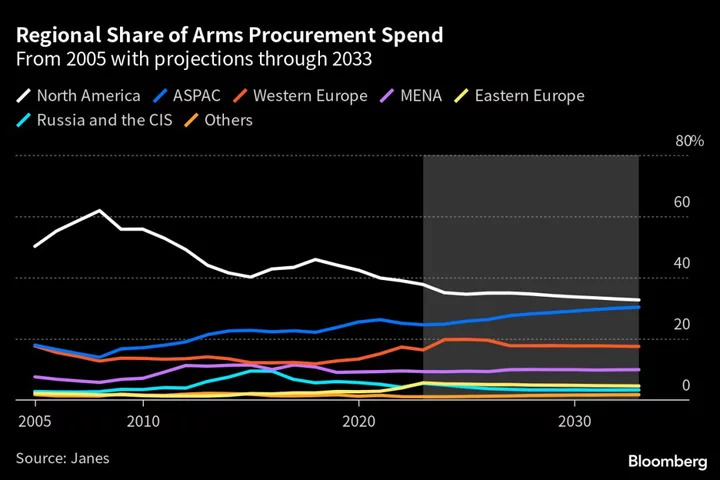Asian leaders accustomed to straddling the US-China divide are increasingly nervous that tensions between the world’s two superpowers could spiral toward conflict, with a series of decisions on both sides making it harder for Beijing and Washington to find common ground.
A defense conference in Singapore this week that could have served as a bridge between the two sides looks instead like it will further highlight the rift over issues including Taiwan, restrictions on high-end chips and China’s claims to a large swath of the South China Sea.
“A lot of us in Southeast Asia are very nervous about Taiwan, seriously,” said Saifuddin Abdullah, a former Malaysian foreign minister whose remarks were echoed by other regional leaders. “We’re very nervous.”
Hopes that the Shangri-La Dialogue kicking off Friday would be the venue for progress in US-China ties were dashed when Beijing rebuffed a US request for Defense Secretary Lloyd Austin and his counterpart Li Shangfu to meet. The US has sought talks for months, but Beijing wants sanctions the US put on Li in 2018 removed, a step the Biden administration considered before ruling out.
Read More: China Spurns US Defense Chiefs Talks, Showing Limits to Ties
So while the military chiefs of the world’s biggest economies will be at the same hotel this weekend, and possibly in the same conference room, they aren’t scheduled to talk. That adds to months of broken communication following a promising meeting between Presidents Joe Biden and Xi Jinping in Bali last November, when the two leaders tried to get the relationship back on track.
It hasn’t happened.
After some tentative outreach, the relationship resumed its downward trajectory when an alleged Chinese spy balloon floated through American airspace in February and the Biden administration ramped up restrictions on technology exports to China.
The US and its allies say they want to “de-risk,” not “decouple,” from China, citing the need to balance trade ties with national security threats from Beijing. Xi’s government rejects that depiction, instead seeing a US-led plot to undercut its growth and encircle it by ramping up defense cooperation with Taiwan, Japan, the Philippines, Australia and other partners.
“Some of the strategic and ideological differences between the two countries appear insurmountable, and may well be irreconcilable,” Singapore Deputy Prime Minister Lawrence Wong said during a conference in Tokyo last month.
Much of Asia — including America’s allies — feel stuck in the middle. And they warily eye the war of attrition unfolding in Ukraine as a stark warning of what could happen if the two rivals don’t stabilize ties.
Ong Keng Yong, the former secretary general of the Association of Southeast Asian Nations, said Washington and Beijing are keenly aware of the parallels.
“Both sides are aware that they cannot afford to make a mistake by going unwittingly into a military conflict,” Ong said in an interview. “The US and China are mindful of the horrible situation that will emerge if there is military confrontation in Taiwan Strait.”
Yet an accidental conflict is always a risk. A Chinese fighter jet last week swerved in front of a US reconnaissance aircraft over the South China Sea in an “unnecessarily aggressive maneuver,” the Pentagon said, part of what a senior American official described as a pattern of confrontational behavior in the region.
Surveying the tensions in the region, Laotian President Thongloun Sisoulith bemoaned the formidable challenges that, left unattended, “could potentially lead to devastating consequences for the world.”
With little sign of a detente, the US and China are digging in. China has continued a years-long effort to militarize contested islands and outcroppings it claims as its own and regularly sends warplanes and ships into traditionally Taiwanese waters. And it has stayed silent as North Korea ramps up its ballistic missile and nuclear program.
Xi this week called for greater efforts to modernize national security defenses and tackle rising risks amid a broader crackdown on overseas access to data and so-called expert networks accused of encouraging the leaking of state secrets.
The US, meanwhile, has sought to strengthen regional alliances. It won promises of more cooperation between Japan and South Korea and opened new embassies in some Pacific Island nations. After years of strained ties with the Philippines, it worked with President Ferdinand Marcos Jr. to gain access to more military facilities and in April kicked off the largest joint military exercise with Manila in 30 years.
Other nations are acting too. Japan Prime Minister Fumio Kishida wants to deepen defense ties with Canada and other Group of Seven countries in Tokyo’s biggest overhaul of security policy since World War II. He’s also overseen an expanded defense pact with Australia, to include intelligence sharing and more sophisticated joint military exercises.
Even without a US-China meeting in Singapore, both sides will be looking to solidify a claim to leadership. The Pentagon said Austin “will meet with key leaders to advance US defense partnerships across the region.”
Austin addresses the Singapore conference on Saturday morning. Li does the same on Sunday.
Among the 600 military officials and delegates from 40 nations attending the conference, there are some who still hope the US and Chinese delegations will find a way to break the ice, even informally on the sidelines.
But it would take much more than one meeting to shift the direction of ties at this point, said Diana Choyleva, chief economist at Enodo Economics, a London-based research firm focused on China.
“Make no mistake, any improvement is at best a minor pause in the intensifying all-out confrontation between the existing and the aspiring hegemon,” she said.
Author: Rebecca Choong Wilkins and Philip J. Heijmans

